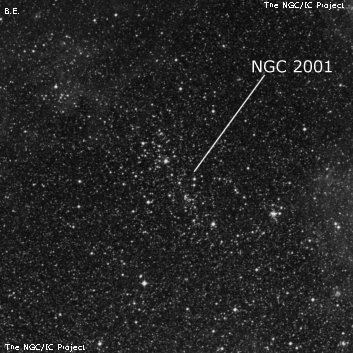
John Herschel discovered NGC 2001 = h2888 on 30 Dec 1836 and recorded "the middle of the most condensed part of a cluster of stars 13th mag which runs off to the south-preceding and joins No. 39 of this sweep." In a separate entry on the same sweep he also mentioned "Here commences a very starry or resolved region of the greater Nubecula."
James Dunlop possibly discovered this association earlier on 25 Sep 1826, recording D 178 as "a small faint nebula with a ray proceeding from it, about 6' or 7' long; a small star is involved in the preceding extremity of the ray." Dunlop's position is 11' ENE of the cluster and Herschel noted the possible equivalence of D 178. Glen Cozens equates NGC 2001 = D 136, which was recorded as "a faint confused pretty large nebula. There are a multitude of small nebulae in this place." The position is D 136 is ~12' SSW of the association and actually falls much closer to NGC 1983. So, I don't see how a specific assignment can be made without additional information, such as similar offsets on the same night.
600/800mm - 25" (10/10/15 - OzSky): a gorgeous, elongated star cloud/association (LH 64), extending 7'x2.5' NNE-SSW. Roughly 65 stars, including a number of mag 12-13 stars are resolved in this region over a glowing background. A mag 10.7 star is at the southwest end and a non-stellar mag 12 knot (KMHK 955) is north of center. A curving chain of a dozen stars pokes out of the west side and heads south towards S-L 495 (3.4' W of the mag 10.7 star). S-L 495 is a very bright, very small knot, 20" diameter. It was difficult to resolve this clump, but a few stars popped. A mag 12.5 star is just off the west edge. LH 58, a stunning large star cloud and HII complex including NGCs 1962, 1965, 1966 and 1970, lies roughly 13' WSW.
Notes by Steve Gottlieb